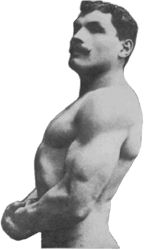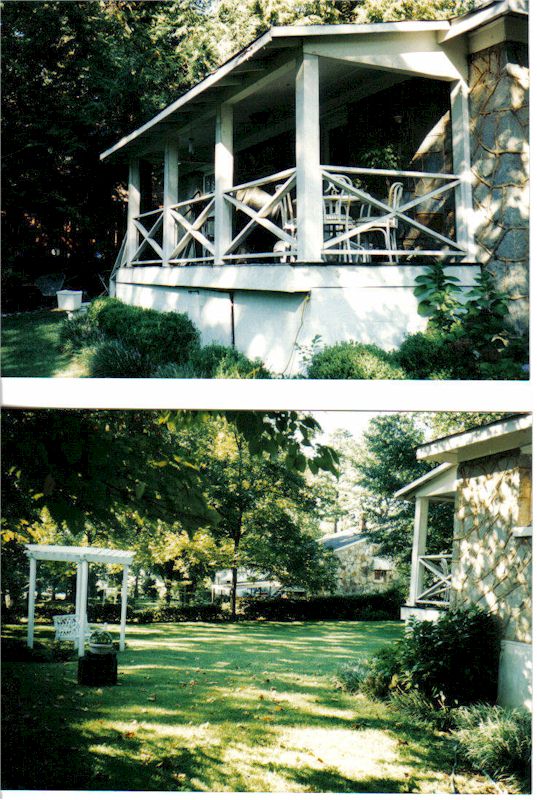
Iron History

Iron History
[Previous entry: "9/10/2004: Fact Sheet of W.A. Pullum�s progress on the One Hand Clean and Bent Press"] [Main Index] [Next entry: "9/24/2004: Edgar Mueller Manuscript"]
09/16/2004 Entry: "9/17/2004: Back Porch Backlift by Paul Anderson, by Joe Roark"
Back Porch Backlift by Paul Anderson, by Joe Roark
[Introductory word: Sometimes when reading a description, we tend to not fully interpret the nuances of what is being written. That is, we do not re-enact using lighter weights the situations we read about, or we do not even imagine re-enacting those lifts step by literal step as though we had been present, thus the reality of specific circumstances is not questioned. In the following scenario, please point out my errors of reasoning if you feel there are any] And, I may just have purposefully left an opening for you to do that�
As of about 1956, Paul Anderson became interested in the backlift after Jack Walsh challenged Paul on the Steve Allen TV show. Walsh had claimed to have bettered Cyr�s record. It was in that year or in 1957 that people began approaching Paul asking, if he was the strongest man in the world, why was he not listed in the Guinness Book of Superlatives for 1956, instead of this entry:
�The greatest weight ever raised by a human being is 4,133 lbs. (1.84 tons) by the 350 lb. French-Canadian, Luis Cyr (1863-1912) in Chicago in 1896 in a back-lift (weight raised off trestles).�
So, Paul began thinking about exceeding that lift, though he had never performed one at the time Walsh challenged him, and had not yet built a platform, and was not sure of the height from the ground such a platform needed to be. He wrote to Tom Ryan many years later, April 1, 1988, that he ��first had to determine just how high I wanted to lift the weight and in what position I would be. I noticed that the back porch of our home, which was not underpinned, looked about the right height. I proceeded to get under the porch and place my hands on a large tool chest that was there. The position felt exactly to my liking, and just for the fun of it, I started pushing. I found that this backlift stance was so sturdy that I continued to push and raised the entire porch from its foundation. I actually believe it was heavier than the official weight I eventually lifted.� Perhaps he had sat on the safe, only a few yards from the porch, as this idea hit him.
That final sentence of the above quote needs explanation. Remember Paul wrote to me that the total amount of the official backlift, listed as 6,270 lbs, was actually about 200 pounds more than that, or approximately 6,500 lbs. So Paul was stating to Tom Ryan that without a warm-up, on his first ever attempt at a backlift, in an impromptu situation, he believed he lifted more than 6,500 lbs. He once told his brother-in-law that he had managed 7,000 lbs but since no witnesses were present, Paul never made that claim public. Perhaps this back porch backlift was the occasion for the 7,000 lbs backlift?
Questions are not answers, but there are several important questions related to the back porch backlift which Paul left unanswered, and those who feel they have the answers, please feel welcome to provide them. I will provide the questions, which in some cases may reveal the answers.
Here is a photo of the current back porch on the house Paul wrote about. I do not know if this is the back porch he described lifting- both are known to have been about as wide as the house, as this photo shows. But I offer the photo for an illustration, not claiming it is the same porch. I suspect the porch Paul mentions is the one shown on page 27 of Randy Strossen�s book, The Mightiest Minister. That porch, in 1955, appears to be far less sturdy and substantial than the photo here. Frankly I lack the skill to estimate the weight of either porch, but my off-handed guess is that neither would weigh three and a half tons. Anyone aware of construction lumber weights etc., feel free to provide input.

Questions:
A backlift platform should be no wider and no longer than is needed, so that balance and stability are increased, and the teetering is minimized. If the porch uprights seen in the photo are six feet apart, this porch may be 18 to 20 feet in length, which would make it the longest backlift �platform� in history. Perhaps it is about six feet wide/deep?
The first problem Paul would have on his first ever backlift would be finding the east-west and north-south center balance points. I am guessing the porch skirting was not present when Paul saw the tool box under the porch , and that the tool box was probably not located at the perfect center balance point until Paul moved it into position.
So Paul moved the tool box to where he guessed the center balance point would be, raised up under the bottom of the porch and had his back pressing against what? Against floor joists! This was impromptu, and there is no mention of having a board ready to use, so his back was pressing against the joists which were how far apart? Standard 16� or wider 24�. If 16� then two joists would be putting more than 6,500 lbs of pressure on very specific rims directly on his back.
The other dilemma regards where the joists were located. That is, under ideal conditions, the center balance point would have been located midway between two joists and when he positioned himself, balance would be there, especially if the joists were 24� apart- otherwise, say if one joist ended up at the perfect balance point he would have it pressing directly on his spine, which would also mean only one joist was being pushed against as Paul�s bi-delt width would not have included another joist even if they were spaced at 16� centers (his shoulders were not 32� wide) and which I hope we can all agree would be impossible to balance. And of course, all this presupposes that he found the perfect balance point on his first attempt and did not tire himself by lifting one end only one or more times before finding the balance point. And of course it is very unlikely that he put his spine perpendicular to the joists.
Also, how high would the center of this lengthy porch have to be raised before the ends would also be raised off their supports- six inches, ten inches- and, how would Paul, with no witnesses be able to ascertain he in fact had cleared all supports? He could hardly glance fore and aft and left and right under more than three tons of pressure could he? Paul wrote Jan 24, 1990 to me regarding his backlifting, �If I could lift it an inch, I could lift it four inches, and that�s the way the 6,000+ pounds was moved.� Would four inches lifted up directly above his back provide enough range of motion to cause the far ends of the porch to leave their supports?
But the crucial question that any experienced lifter must ask himself is this: When you are trying a new lift for the very first time, and are not warmed up in that movement, do you believe the amount you could lift on that initial, unskilled, attempt would be greater than what you would be able to lift after an additional 12 to 18 months training? This is what we are being asked to believe: that Paul, having lifted the porch, later concluded, that his record backlift was in fact lighter than the back porch backlift. Why train then? Have you ever had to train to lift a lighter weight than you just lifted on a first ever try at that lift? Do not lighter weights come easier even without training?
And at what point in his training did Paul realize the back porch was heavier? If, using his numbers, that is: an 1,800 pound platform and a 3,500 pound safe were used as a starting point- which would total 5,300 pounds- surely that was noticed as lighter than the porch? Indeed it is 20% or so lighter. In fact, of course, we must alter the 3,500 pound safe down to its accurate weight of about 2,300 lbs, so his beginning backlift (if that�s what was employed) would have been 4,100 pounds- or 2,400 lbs lighter than the porch- a veritable warmup. Of course, I believe the weight of the platform must also be reduced to much less than 1,800 lbs, but the relevant point for this purpose has been made, I trust, that the beginning weights were so low that he surely would have made much more rapid progress since in fact if this story is accurate, he had ALREADY exceeded what he spend a year or more training for.
It is almost the reverse of Milo of Crotona�s training method �
Now, some of you may have read this far and thought that I should have read Paul�s biography and I would have known that my dates are way off. Actually, the biography cannot be accurate since it is not consistent with itself, when it offers, �By June 1957 [1957?] people had begun to ask�� about Cyr being in Guinness and Paul not. So Paul continues �I trained long and hard between exhibitions at weightlifting meets and in nightclubs�� for the backlift record attempt. Let�s examine this timeline.
Being as lenient as we can be, if people began asking about the Cyr entry on June 1, 1957, Paul would have had eleven days in which to spy the porch height, backlift the back porch, lift in exhibitions around the state or country, appear in nightclubs around the state or country, return to help his father build the backlift platform to be used, all the while somehow training long and hard. The longest he could have trained would be eleven days even if he had built the platform the same day as he tried the back porch backlift. And then surely he would have immediately known that his early poundages on the newly constructed platform were much lighter than the back porch backlift.
So the reference to June1957 cannot be accurate.